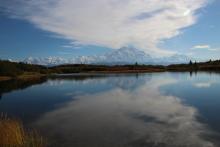Update
Now Archived! PolarConnect event with Kim Young and researcher Christina Minions from Weston, Massachusetts on 8 April 2019. You can access this and other events on the PolarConnect Archives site.
What Are They Doing?
 The smaller CO2 Flux Chambers, FC, are the control chambers and do not warm the ground. Photo by John Wood
The smaller CO2 Flux Chambers, FC, are the control chambers and do not warm the ground. Photo by John Wood
This NASA-funded project aims to improve understanding seasonal changes in the amount of carbon dioxide (CO2) released from permafrost soils in Alaska. This project is very exciting because they are using soil flux chambers that are capable of monitoring CO2 during the cold winter months. Information resulting from this study will be used to improve the understanding of local earth systems processes that affect carbon flux in various parts of Alaska.
Where Are They?
 An aerial view of Barrow, Alaska. Photo by John Wood.
An aerial view of Barrow, Alaska. Photo by John Wood.
The team will reach the field sites at Eight Mile Lake, along the Dalton Highway, Toolik and Utqiaġvik (Barrow) via truck and up to 3 miles of hiking. Atqasuk is reached by small plane.
Toolik Field Station is operated by the Institute of Arctic Biology (IAB) at the University of Alaska Fairbanks (UAF) and has hosted hundreds of researchers and students every year since 1975. We will also conduct research at the Eight Mile Lake watershed on the North Slope of the Alaska Range near Healy, Alaska. The Eight Mile Lake site has been affiliated with the Bonanza Creek LTER and IAB at UAF since 2008.
Latest Journals
Sue Natali is an assistant scientist at Wood Hole Research Center (WHRC). Her research focuses on the interactions and feedbacks between plant and soil communities and their environment and seeks to better understand the impacts of environmental change on ecological processes and biogeochemical cycles. Dr. Natali conducts her research in boreal and tundra ecosystems in Alaska and Siberia. Learn more about Dr. Natali and her work at the WHRC webpage.





